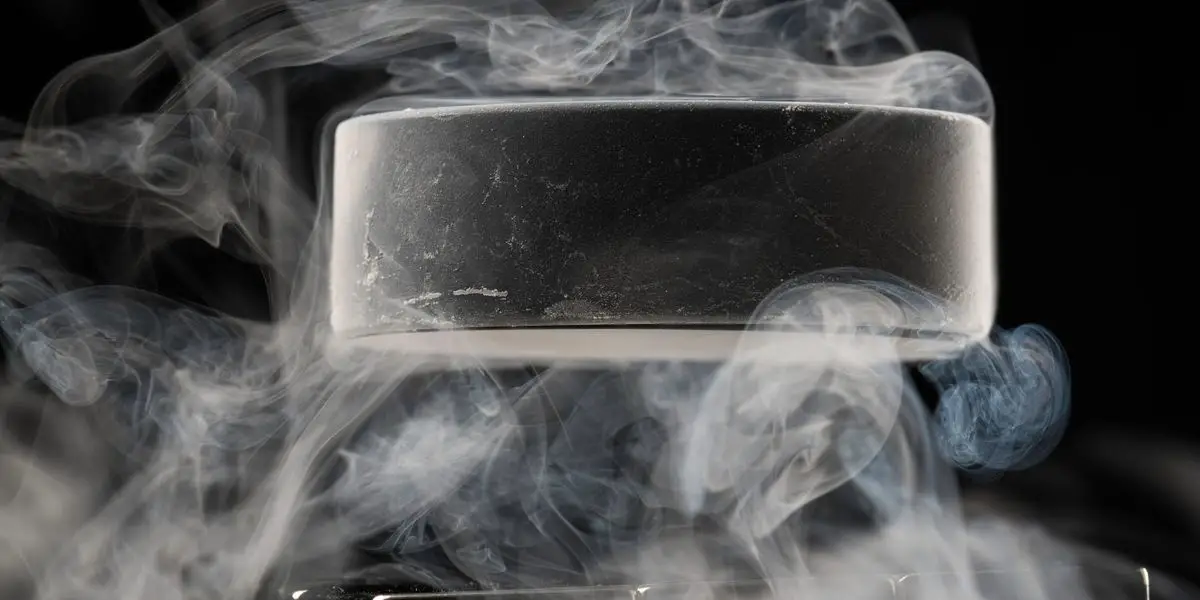Scientists today reported that they’ve observed room-temperature superconductivity. Superconductivity is a rarefied state of matter in which electrical resistance in a material drops to zero while its electrical and magnetic capacity vastly expands. Until now, the phenomenon has been observed only at cryogenic temperatures or phenomenally high pressures. Such a discovery, if confirmed, could open pathways to a range of applications including lossless electric transmission, high-efficiency electric motors, maglev trains, and low-cost magnets for MRI and nuclear fusion.
However, the caveats attached to today’s announcement are considerable. While the researchers say their material retains its coveted lossless properties at temperatures up to 20.6 ºC, it still requires substantial pressure (10 kilobars, or 9,900 atmospheres). Today’s publication is also tarnished by the fact that the scientists behind the discovery, publishing their work in today’s issue of the journal Nature, have retracted a previous paper on room-temperature superconductivity because of its unconventional data-reduction methods.
The primary researcher Ranga Dias—assistant professor in the departments of mechanical engineering and physics and astronomy at the University of Rochester—said the retracted research paper has since been revised to accommodate the criticisms and accusations. Originally published in Nature as well, the revised version is back under peer review with Nature, Dias said.
“We’ve made an open-door policy. We [allowed] everybody to come to our lab and see how we do the measurements.”
—Ranga Dias, University of Rochester
Last fall, when the group’s previous paper (reporting similarly compelling results involving a much higher-pressure material inside a diamond anvil) was retracted, many criticisms and even allegations of misconductdogged the team across the science press. “I think this is a real problem,” Jorge Hirsch, professor of physics at the University of California, San Diego, told Science at the time. “You cannot leave it as, ‘Oh, it’s a difference of opinion.’ ”
Contacted by Spectrum, Hirsch said his views today—alleging misconduct—have only strengthened since then. According to him, some of Dias’s group’s reported data was allegedly computer-generated—a feat that Hirsch’s team says they can reproduce out to seven-digit accuracy. “When you read the paper, it superficially looks great. … [And] if this is true it is an incredible breakthrough, worthy of a Nobel Prize. But when you look more carefully several warning signals become apparent,” Hirsch said via email.
Venkat Viswanathan, associate professor of mechanical engineering at Carnegie Mellon University, in Pittsburgh, said the degree of controversy the retraction merited may have been overstated. “It was unfortunate what happened,” he said. “But a lot of people seized on it. If people took a serious look at the work itself and all that’s transpired since, I think the data is still solid. It’s still very attractive for superconductivity.”
Paul C.W. Chu, professor of physics and founding director at the Texas Center for Superconductivity at the University of Houston, said he has seen many claims of high-temperature superconductivity in his more than half century in the field. Many such claims did not pan out. (He has also, in his time, grabbed headlines for high-temperature superconductivity claims—in his case, claims that were true and advanced the field.)
Spectrum spoke with Chu hours after Dias’s group had presented their findings to this year’s March Meeting of the American Physical Society, the same meeting that in 1987 Chu had legendarily presented some of his own groundbreaking superconducting discoveries. Chu said he is especially cautious about the Dias group’s background subtraction methods. Background subtraction is not uncommon in the field, he said. But in this case, the signal is small compared to the noise. So, he said, “the background subtraction has to take place carefully.”
Still, Chu continued, “It is a very nice experiment. This is definitely significant, if it is proven to be real.”
According to James Walsh, assistant professor of chemistry at the University of Massachusetts Amherst, some of the controversy behind the group’s findings may be related to the challenges posed by the medium itself. “High-pressure science imposes experimental difficulties that simply don’t exist with traditional methods,” he told Spectrum via email. “It is hard to overstate the skill and ingenuity of the high-pressure community that has made magnetism and resistivity data accessible at all.”
Because of the increased scrutiny occasioned by the Dias group’s publication history—as well as the outsized significance of the group’s new finding—Dias said that his team has abided by increased levels of transparency and repeatability.
“The history of materials science has shown us that technological leaps can often be traced back to the announcement of a newly discovered material with outstanding properties.”
—James Walsh, University of Massachusetts Amherst
“We’ve made an open-door policy,” Dias said. “We [allowed] everybody to come to our lab and see how we do the measurements. During the review process, we shared all our data with the referees.”
He added that in collecting data for their revised previous paper, the researchers collaborated with officials from Argonne and Brookhaven National Laboratories. “We did the measurements in front of a live audience,” Dias said. “They showed the superconducting transition. We are collaborating with both labs to understand the material properties and understand the exact structure of the material.” (A spokesperson for Argonne, contacted by Spectrum, said that U.S. Department of Energy policy prohibits them from speaking about research appearing in papers that their group did not author.)
The centerpiece material in the present research—the putative 10-kilobar superconductor—is sure to be the subject of a flurry of both controversy and at least short-term interest. The recipe for what the team calls “reddmatter” (a Star Trek reference) involves hydrogen, nitrogen and the 71st element on the periodic table, lutetium (Lu).
Carnegie Mellon’s Viswanathan said today’s discovery may represent the biggest gold rush on lutetium in the rare earth’s entire history. “He has singlehandedly spiked the metals index for this element,” he said of Dias.
Walsh, of the University of Massachusetts, expressed enthusiasm for the material itself—named for its ruby red hue in its high-pressure state. “The history of materials science has shown us that technological leaps can often be traced back to the announcement of a newly discovered material with outstanding properties,” he said via email. “It would be hard to argue that a result like this should not qualify.”
These microphotographs show the lutetium nitrogen hydrogen material (a.k.a. “reddmatter”) that researchers report superconducts at high pressures. Curiously, also at high pressures the previously blue material turns ruby red.Ranga Dias/University of Rochester
Of course, a result like this also requires highly pressurized cells, which might only swap the cryogenic equipment required for present-day superconductors with a different kind of elaborate, expensive, and unwieldy roomful of hardware. Chu says he will be collaborating with researchers investigating ways to transform rare-earth materials like the lutetium nitrogen hydrogen compound into superconductors that require substantially less pressure.
“These high-pressure cells interfere with measurements, and if you talk about applications, it’s not practical,” he said. “We want to see if we can stabilize it without pressure.”
Such notions have parallels in other fields. In semiconductor engineering, strained silicon transistors can retain in their lattice effective pressures three or more times as great as the pressures involved in the present material.
Eva Zurek, professor of chemistry at the University at Buffalo in New York state, said independent confirmations of the Dias group’s work are essential. But if the finding is validated, then she anticipates a challenging but not impossible road to develop a material that can perform at something close to ambient pressures as well as temperatures.
“If [the new finding is] proven to be true,” she said via email, “then I believe it would be relatively straightforward to either find ways to bring Lu-N-H to normal pressure/temperature conditions, or develop technologies where it may be used at very mild pressures.”
Update 13 March: The story was updated to include new remarks from Prof. Jorge Hirsch, a response to a call for comments that had arrived after this article was originally published.
From Your Site Articles
Related Articles Around the Web
Source link











Leave a Reply